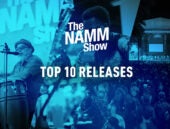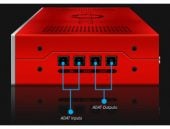-
In theory, it’s definitely possible, but in practice it can be a little bit cumbersome. The advantage of using a USB microphone is that you have a great all-in-one setup without needing to use an audio interface. But if you want to use more than one USB mic, things get pretty complicated for your computer. Also, hooking two USB microphones up to a computer kind’ve defeats the purpose of using a USB microphone. But, can it actually be done?
-
In this blog, we’re going to talk about playing the blues, show you which ingredients are needed to play typical blues-flavoured sounds on a piano or guitar, and take an in-depth look at blue notes, blues scales, blues-style chord progressions (including that well-known 12-bar blues), straight-versus-swing blues and various other important topics.
-
Despite the fact that setting up and teaching classes online is easier than ever in today’s digital age, there are lots of tutors, coaches and private teachers who struggle with the audio quality of their live-streams – even when their internet connection is working just fine. Since comprehensible speech is essential for getting any kind of message across, the sound needs to be spot-on. In this blog, I’m going to explain how you can take the audio quality of your online classes to the next level and, no, you don’t necessarily need to invest in a new microphone!
-
Ionic, dorian, phrygian, lydian, mixolydian, aeolian, and locrian: otherwise known as the church modes. These influential scales originated in the church music of the middle ages and are still used today in classical music, pop, jazz, rock, and even metal. So, if you want to try something new or take in a little musical history, it’s worth learning a few church modes. In this blog, you’ll get an idea of how these modal scales work, an impression of the kind of sound they can produce and learn to play them in any key.
-
A question we’re often asked is, ‘how do you connect a keyboard or digital piano to a mixer or keyboard amplifier?’ Maybe you’re preparing for your first ever live gig, maybe you’re figuring out how to make home-studio recordings, or your sonic instrument of choice needs more volume if it’s going to compete with your drummer in the rehearsal room. If you’re not familiar with them, the sheer number of different ways of connecting up your gear can be a little overwhelming. But luckily, it’s all pretty straightforward once you know how.
-
There comes a time in every musician’s life when they are forced to confront a mixer for the first time. To the un-schooled user, these chunks of equipment can seem intimidating and complex, and while mixers range from the super-compact to the desk-sized gigantic, all of them are based on the same set of principles and will offer the same basic set of functions and connection options. In this blog, we offer a step-by-step explanation of the ins and outs of mixers.
-
Say you’ve got a keyboard or digital piano and want to hook it up to a tablet or smartphone and see what it can do alongside the many sound-generating and tweaking apps out there. In this blog, we will find out if your keyboard or piano will be compatible, what kind of software you’ll need, and more!
-
Just as important as finding your perfect ukulele is finding the right set of ukulele strings to go along with it. Although all ukuleles come with strings already fitted, they may not necessarily be the best fit for your own personal playing style or preferences. It’s important to know what strings are available for you to consider. The subject of ukulele strings can become a never-ending rabbit hole, but guest blogger Matthew Quilliam shows that it doesn’t have to be so complicated.
-
Heads up if you’re an avid, ambitious user or producer working from a home studio. In this blog, we offer you a number of suggestions that can help you expand your current audio interface. If you’re thinking about upgrading, don’t sell it just yet!
-
If you’ve played on stages before, you’re probably well aware of the sonic nuisance that is feedback. In this blog, we explain how you can counter feedback and keep the ears of your audience members from bleeding.
-
A songwriter’s dream come true: an original, fresh, new melody jaunting into your mind while you sleep. Guest blogger, Caro, explores this dream phenomenon. Be it a ‘jingle dream’ or ‘symphony nightmare’; how can we coerce a dreamt-up, freshly invented melody from our sleep and bring it to the forefront of our minds? To kick start, you need to reach REM-sleep (Rapid Eye Movement), dream a melody, and then recall it. It’s fun, efficient and free! What’s not to love?
-
Guitarists will already be aware of the unmistakable effect the humble valve can have on their sound. While there are at least 25 different kinds of valves found inside various different guitar amplifiers, there are four that you’re most likely to come across. Here, we cover each of them so you can get to know exactly what’s shaping your tone.
Sign up for the Bax Music Blog Update!
Just fill in your email address and we'll drop a fresh instalment of blogs in your mailbox every month so you never have to miss out again.
Subjects
About Bax Music
Bax Music is your go-to online music store in the UK with more than 48,000 bits of gear and accessories in stock. More than 1,000 brands and a 26,000m2 warehouse packed with musical instruments, DJ and studio gear, headphones, speakers and lighting. Ordered before 10 PM? Receive delivery in 2 - 4 business days.
Wanted: Guest Blogger!
Become a Video Reviewer!
Recent Posts
 NAMM 2025 – Top 10 Releases30 January 2025
NAMM 2025 – Top 10 Releases30 January 2025 Picking Out the Right PA System for a Wedding29 January 2025
Picking Out the Right PA System for a Wedding29 January 2025 The History and Features of Hard Rock and Heavy Metal29 January 2025
The History and Features of Hard Rock and Heavy Metal29 January 2025 How to Start a Band29 January 2025
How to Start a Band29 January 2025 How to Be a Wedding Singer28 January 2025
How to Be a Wedding Singer28 January 2025 Does a Good Musician Make a Good Band Mate?28 January 2025
Does a Good Musician Make a Good Band Mate?28 January 2025 Hybrid Drums: The Best of Both Worlds28 January 2025
Hybrid Drums: The Best of Both Worlds28 January 2025 How Do You Tune a Mixer, Speakers and Amplifier to Each Other?28 January 2025
How Do You Tune a Mixer, Speakers and Amplifier to Each Other?28 January 2025 Relic’ing a Guitar or Bass: How and Why23 January 2025
Relic’ing a Guitar or Bass: How and Why23 January 2025 A 5-Step Guide to Clean Recordings for Budding Mixing Engineers23 January 2025
A 5-Step Guide to Clean Recordings for Budding Mixing Engineers23 January 2025
Recent Comments
- Marnix | Bax Music on Special Chords: Rare but Useful
- Fungk on Headless Guitars: The Pros & Cons
- Johnny B. on Special Chords: Rare but Useful
- Black Beauty 16 on The Snare Buzzes When I Hit the Tom: Can I Fix it?
- Stefan | Bax Music on Phantom Power: This is What You Need to Know
- Marnix | Bax Music on How To Connect A Record Player To An Amplifier Or Pair Of Speakers
- Lily on How To Connect A Record Player To An Amplifier Or Pair Of Speakers












